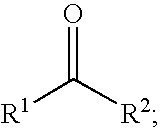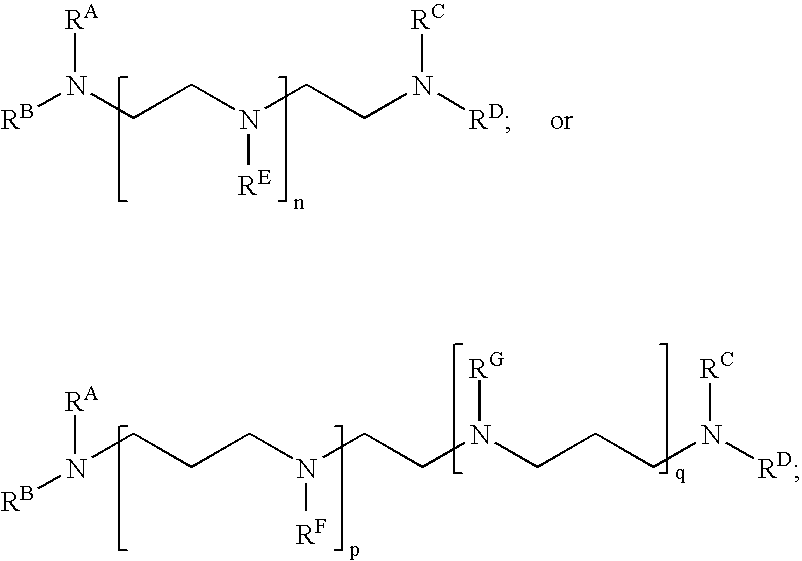Alkylated Polyalkyleneamines and Uses Thereof
a technology of alkylated polyalkyleneamine and polyalkyleneamine, which is applied in the direction of adhesives, adhesive types, coatings, etc., can solve the problems of amine migration to the coating surface, poor surface appearance of the coating made from aqueous amine-epoxy compositions, and many industry problems, so as to achieve good hardness development, good stability, and high gloss
- Summary
- Abstract
- Description
- Claims
- Application Information
AI Technical Summary
Benefits of technology
Problems solved by technology
Method used
Image
Examples
example 1
Synthesis of Benzylated Ethylenediamine (EDA) at a 1.1:1 Molar Ratio
[0167]180.3 g of EDA (3.0 moles) and 2.7 g of Pd / C catalyst were placed in a 1-liter autoclave batch reactor. The reactor was sealed and subsequently purged with nitrogen and then with hydrogen to remove any air from the reactor. Over a time period of about 15 to 20 minutes, 350.1 g of benzaldehyde (3.3 moles) were added to the reactor. After the addition of the benzaldehyde was complete, the reactor contents were stirred for an additional 15 minutes or until the reaction was complete, at which time the reaction exotherm began to subside. At this point, the reactor was pressurized to 120 psi with hydrogen and the reactor was heated to 80° C. When the rate of hydrogen uptake slowed, the pressure was increased to 800 psi and the temperature was increased to 120° C. The hydrogenation process continued until the rate of hydrogen uptake fell below 0.0034 MPa / min (0.5 psi / min). The total hydrogenation time was about 5 hou...
example 2
Synthesis of Alkylated Diethylenetriamine (DETA) at a 1.2:1 Molar Ratio
[0168]397.2 g of DETA (3.78 moles) and 6 g of Pd / C catalyst were placed in a 1-liter autoclave batch reactor. The reactor was sealed and subsequently purged with nitrogen and then with hydrogen to remove any air from the reactor. Over a time period of about 15 to 20 minutes, 268.3 g of acetone (4.63 moles) were added to the reactor. After the addition of the acetone was complete, the reactor contents were stirred for an additional 15 minutes or until the reaction was complete, at which time the reaction exotherm began to subside. At this point, the reactor was pressurized to 120 psi with hydrogen and the reactor was heated to 80° C. When the rate of hydrogen uptake slowed, the pressure was increased to 800 psi and the temperature was increased to 120° C. The hydrogenation process continued until the rate of hydrogen uptake fell below 0.0034 MPa / min (0.5 psi / min). The total hydrogenation time was about 5 hours. Th...
examples 3-5
Synthesis of Benzylated Diethylenetriamine (DETA) at Varying Molar Ratios
[0169]Examples 3-5 utilized the same process as described in Example 1. The molar ratio of benzaldehyde to DETA was 1.2:1 for Example 3,1.5:1 for Example 4, and 2:1 for Example 5. These reactant ratios are indicated by the degree of alkylation in Table 1. Additionally, Table 1 lists the viscosity, AHEW, theoretical amine value, and actual (measured) amine value properties of the benzylated DETA reaction products of Examples 3-5.
PUM
| Property | Measurement | Unit |
|---|---|---|
| temperature | aaaaa | aaaaa |
| time | aaaaa | aaaaa |
| temperature | aaaaa | aaaaa |
Abstract
Description
Claims
Application Information
 Login to View More
Login to View More - R&D
- Intellectual Property
- Life Sciences
- Materials
- Tech Scout
- Unparalleled Data Quality
- Higher Quality Content
- 60% Fewer Hallucinations
Browse by: Latest US Patents, China's latest patents, Technical Efficacy Thesaurus, Application Domain, Technology Topic, Popular Technical Reports.
© 2025 PatSnap. All rights reserved.Legal|Privacy policy|Modern Slavery Act Transparency Statement|Sitemap|About US| Contact US: help@patsnap.com



